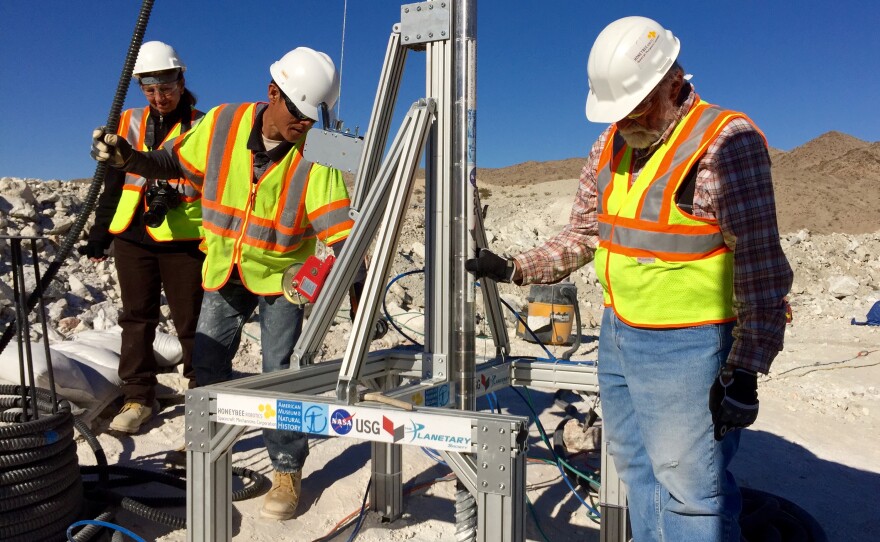Planetary scientists intend to use a new type of drill to look for signs of life far beneath the surface of Mars. But before the drill can be used in space, engineers must first try it out in the most similar environments Earth can provide.
A California gypsum quarry is the first test site of the Planetary Deep Drill.
“Here, this gypsum is like 200 feet thick. So this deposit is massive,” said John Bowsher, quarry manager with the United States Gypsum Company (USG).
Since the 1920s, this white mineral tucked into the mountains near the Salton Sea has been drilled and blasted and hauled away in bits.
“The name is Plaster City, because a lot of the early mining was used for plaster business,” Bowsher said.
Gypsum mined today is primarily used to make drywall. The quarry looks like another world.
The scientific team developing the new Planetary Deep Drill chose the site because gypsum is similar to soft Martian rocks. Gypsum is also close in strength to cryogenic ice that has formed over millions of years on the polar caps of Mars and the crusts of moons of Jupiter and Saturn.
The drill is designed to go kilometers through both rock and ice, in search of past or present life that may exist in subterranean lakes and aquifers on Mars or Europa or Enceladus.
USG geologists identified a location with thick, uniform gypsum for Honeybee Robotics engineers to evaluate their prototype drill. After a couple of years of development and laboratory testing, the portable drill is now entering the first round of field tests just three hours from the lab, in case things go awry.
Right now, it’s mostly quiet in the makeshift Mission Control inside a U-Haul trailer, aside from the buzz of a generator. Bolek Mellerowicz, Honeybee Robotics engineer, said things are working like they should be.
“For some of the other engineers, it’s boring,” Mellerowicz said. “But for me, I’m content when things are like this.”
The prototype is a 15-foot long cylinder with a 15-inch stronger-than-steel tungsten bit. It’s attached to a Kevlar tether that contains data and power cables connected to the trailer and generator.
Inside the trailer, the engineering team completes a series of tasks: They monitor the drill, check its position, send commands, and log data.
“So we get velocity, current, temperature of the electronic drives that are imbedded, as well. We gather images from the microscopic camera,” Mellerowicz said.
The drill is equipped with temperature and humidity sensors, UV and fluorescent lights, and notably a mounted microscope that can take images with a resolution of 0.5 microns per pixel. The microscope will be able to search for some of the smallest forms of life.
For missions to Mars and other planetary targets, the drill needs to be lightweight and low-power to operate on a rover. It’s designed to work on just 100 watts, about the amount of energy a lightbulb uses.
And instead of relying on the heavy overhead mass and hydraulic pressure like standard mining production drills, the Planetary Deep Drill uses a lightweight anchor system.
“We have anchors that brace the drill against the borehole wall,” Mellerowicz said. “So the drill can apply as much downward force, as much as it’s capable of.”
The drill hammers and rotates and moves downward slowly, just fractions of a millimeter per second.
Every half hour or so, an alarm lets the engineers know when the drill has hit the correct depth. Today, that’s about seven meters below ground.
The team then pulls the drill back up to the surface. A member of the engineering team grabs a plastic sample bag and deposits the finely-ground white gypsum dust that collected inside the hollow drill bit. These drilling and sampling actions will be automated when the drill is attached to a rover.
The confirmation of water on the surface of Mars may yield more wonders.
Curator of astrophysics at the American Museum of Natural History Michael Shara said while radiation and low temperatures kill life on the surface of the Red Planet, the conditions deep in the interior are more hospitable. He’s a principal investigator for the Planetary Deep Drill project.
“If we hit a water level in Mars, and the water is absolutely sterile – there’s not sign of anything living down there – then we’ve probably answered the question is there life on Mars in the negative,” Shara said. “Now, I’d be really surprised if that were the case, you know as a scientist you have to keep an open mind.”
Engineer Janice Buckner leads the instrument development programs, PICASSO (Planetary Instrument Concepts for Solar System Observations) and MatISSE (Maturation of Instruments for Solar System Exploration), for the planetary science division at NASA Headquarters.
She said the Curiosity rover currently drilling on Mars has just scratched the surface, sampling between two and three inches underground.
“It’s helpful if we can drill down deeper into the surface of that planet, whether it’s through the soil or through ice, so we can obtain samples that will tell us a little more about the history of that planet,” Buckner said.
The Planetary Deep Drill hasn’t been assigned to a mission yet. But on the next version of the drill, NASA will supply spectrometers that can detect carbon molecules and minerals formed by water.
“We’ve gained a lot of insight just by being here three weeks drilling in gypsum,” Mellerowicz said.
The team already has ideas such as adding another set of anchors to stabilize the drill while navigating unseen underground cavities.
Once the gypsum trials are complete, Honeybee Robotics will begin tests with the next iteration of the drill in the glaciers of Greenland.
The American Museum of Natural History, NASA, The Planetary Society, and United States Gypsum Corporation are sponsoring the Planetary Deep Drill project.








